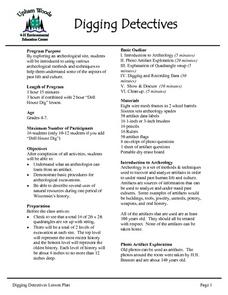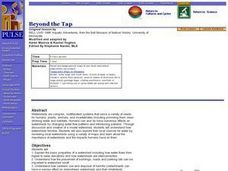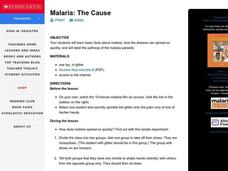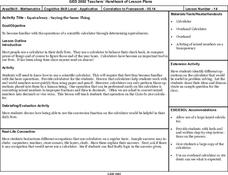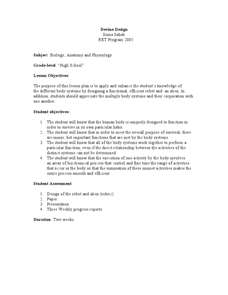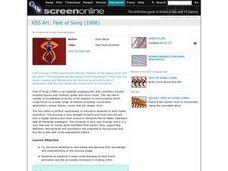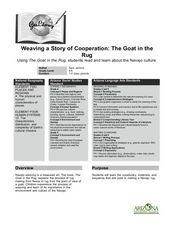Curated OER
The Constitution Lives! How it Protects Your Rights Today
Students brainstorm their rights as Americans. In this The Constitution Lives! lesson, students discern the difference between rights and rules by completing a worksheet. Students consider the differences between types of constitutional...
Curated OER
Mystery Island Greg Hansen
Fifth graders explain how human activities shape the earth's surface.
Curated OER
Digging Detectives
Students demonstrate basic procedures for archeological excavations. They explore an archeological site, students using various archeological methods and techniques to determine some of the aspects of past life and culture.
Curated OER
Bioethics and the HGP
Young scholars analyze case studies using the rules and principles of ethics. They comprehend which rules and principles of theics are of great importance to the Human Genome Project. Students participate in mock student hearings.
Curated OER
Stewardship Letter
Young scholars write a persuasive letter. In this stewardship lesson, students discover the basic format for a formal letter and some effective persuasive techniques. Young scholars write a letter to bring about change in the way...
Curated OER
Beyond the Tap
Students explain the basic properties of a watershed including how water flows from higher to lower elevations and how watersheds are interconnected. They comprehend how the placement of buildings, roads, and parking lots can be...
Curated OER
The Ottoman Empire
Pupils compare the basic religious beliefs/and value systems of the three major religions that developed in the Middle East. Each group focuses on one of the religions, then reports to the rest of the class.
Curated OER
Spatial Understanding of the Cities and Towns
Students engage in a fun stand up, move around activity that teaches some basics of geography. They develop concepts of distance between community locations and practice giving and taking directions in an organized manner.
Curated OER
Malaria: The Cause
Young scholars explore the basic facts about malaria. They study how the disease can spread so quickly and label the pathway of the malaria parasite.
Curated OER
Ghosts of Rwanda Pre-Viewing Lesson Plan
Students watch a film about the history of Rwanda and discuss the meaning of genocide. They study the basic principles of the United Nations and examine how point of view effects the reporting of history.
Curated OER
Genetic Health Forum (G.H.F.)
Young scholars achieve a week long activity in preparation for a group presentation on a human genetic condition
Curated OER
Realtor Role-Play
Students play the role of realtors with other classmates as the prospective homebuyers. The "realtors" determine questions to ask the prospective homebuyer so that they can help the "homebuyers" find the home best suited to their needs...
Curated OER
Winer Survival
Students study how animals need water, food, shelter, and space to survive. They also study what animals need to survive in the winter. They play the part of animals and winter "threats" in a game of tag to reinforce concepts.
Curated OER
Geographic Information Systems
Young scholars examine the concept of geographic information systems (GIS) and its basic components. They explore an application program using GIS technology and list the various uses for GIS.
Curated OER
Equivalency-Saying the Same Thing
Fifth graders use a scientific calculator to practice finding equivalencies They discuss the possible uses for the scientific calculator. They experiment with other basic functions using the calculator.
Curated OER
Devine Design
Students examine the functions of the different systems in the body. They discover how different systems must work together to make the body function correctly. They identify the needs of the body to help it survive.
Curated OER
The Fossil Record
High schoolers research about the animals found in Burgess Shale. In this earth science lesson, students evaluate the significance of fossils in human history. They create models of their chosen animal.
Curated OER
Touch the Past: Archaeology of the Upper Mississippi River Region
Students examine the archeology of the Mississippi River Valley. Using the internet, they expand their research to include how the Native Americans in California used plants to meet their needs. They also research a Native American...
Curated OER
Feet of Song
Learners establish a basic definition of stop frame animation and the processes involved in creating a film. Through guided practice and film reviews, they create their own stop motion animation in response to a film they have seen.
Curated OER
Weaving a Story of Cooperation: The Goat in the Rug
Weaving is an important part of Navajo culture. Read The Goat in the Rug to your fourth and fifth graders, and give them a glimpse into the process of rug making from the point of view of a goat! They will learn new vocabulary words and...
Roy Rosenzweig Center for History and New Media
Differences Among Colonial Regions
Classes look at and analyze primary source images to explore the differences between the colonial regions during the Revolutionary era. They break into groups to tackle each region and then present their findings to the class. A final...
Curated OER
Settlement Exploration: Then and Now
NASA has crafted an imaginative and memorable series of lessons, "NASA and Jamestown Education Module." This instructional activity is one of the five components. In it, middle schoolers connect history and science by comparing the...
Global Oneness Project
Citizen Photojournalism
Matt Black's photo essay, "The Geography of Poverty" provides a shocking reminder of the poverty that exists in the United States. The resource not only focuses attention on poverty but also conditions that have given rise to situation...
Curated OER
Anatomy of the Brain
Learners explore the brain. In this science lesson, students view a diagram of the brain and discuss the various regions of the brain. Learners discuss the importance of protecting the brain and design a protective covering.




